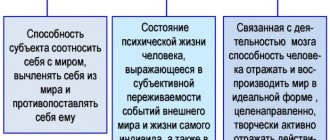What are sensations? To talk about sensations means to refer to the human body and all its nerve endings that help us get in touch with the world inside us and the world outside us.
Various types of sensations refer to the basic direct experiences caused by simple isolated stimuli. Sensation is also defined as the response of the sense organs to a stimulus. These are conscious captures of the properties of objects, things and phenomena.
Sensation is only the first stage of cognition, which through thought transforms data into ideas, concepts, laws, etc. And those, in turn, more deeply reflect the objective world and the accuracy of which is verified by practice. A sensation occurs when a stimulus impacts a receptor.
Although the concepts of sensation and perception are often used interchangeably, they differ in many details.
Sensation is the experience experienced by a stimulus in the form of a response to a sensory experiment, while perception is the interpretation of sensation that gives meaning and order.
Definition
Sensation is a spontaneous mental phenomenon that arises as a result of the direct influence of things of the objective world on the sense organs (analyzers) of animals and humans, an influence that is subjectively felt as the quality of the things themselves (red, cold, prickly, etc.). Sensation is secondary to material reality.
The term sensation has several meanings, for example it can refer to the impression that an object makes through the senses, that is, it becomes the immediate response of the sense organs when they receive a stimulus.
It also alludes to the surprise effect that people have when they are surprised by something or someone. Another definition refers to an intuition or feeling that an event or problem may occur to a person.
Sensation involves the optimal functioning of the senses and nervous system, and under normal conditions it results in what we can see, for example, red when it is red and green when it is green.
↑ Process of cognition
The process of cognition, no matter how it takes place, always presupposes the presence of two sides: the subject and the object of cognition.
Subject of knowledge
- a cognizing person, endowed with will and consciousness, or a collective, the whole society.
Object of knowledge
– what the subject’s cognitive activity is aimed at. Can be animate (a person himself, an animal) and inanimate (natural phenomena); material (really existing object) or ideal (hypothesis, theory)
Means of knowledge
- devices used to obtain knowledge (measuring instruments, microscopes, reagents)
Result of knowledge
- knowledge is a product of the relationship of thought to reality, existing in a logical linguistic form in the form of concepts, judgments, symbols, signs
Knowledge consists of two levels: empirical and theoretical
. But it is impossible to contrast the sensual and rational in cognition, since these two stages of cognition manifest themselves as a single process. The difference between them is not temporary, but qualitative: the first stage is lower, the second is higher.
Knowledge
is the unity of sensory and rational knowledge of reality. Knowledge is the result of knowledge of reality, the content of consciousness.
Outside of sensory representation, man has no real knowledge. For example, many concepts of modern science are very abstract, and yet they are not free from sensory content. Not only because these concepts ultimately owe their origin to the experience of people, but also because in their form they exist in the form of a system of sensory signs. On the other hand, knowledge cannot do without the rational data of experience and their inclusion in the results and course of the intellectual development of mankind.
Characteristics and properties of sensations
- Characteristics:
- Sensation is an innate phenomenon . It has not been fully studied. You are born with the ability to receive sensations.
- The need for intensity or strength of sensation so that the stimulus is captured and its variations can be appreciated. The intensity of the sensation depends on the intensity of the stimulus. There is a difference in intensity that a stimulus requires in order for the subject to become aware of it. This is called a threshold.
- Duration: the time of constancy of sensation, that is, irritation of receptors. For example, auditory and visual sensations are short-lived, but painful sensations are long-lasting.
- The affective tone or state of mind of a subject, determined by the motives, expectations and experiences that he experiences and which influence both the predispositions and the ability to perceive, as well as the intensity of stimuli that must be captured and interpreted in the psychological field and they are individual.
- Sensational content: Content influences the perception of stimuli according to the relationships it has with motives, interests, expectations, and affective tone. We usually grasp with greater speed and intensity what interests us. And sometimes the same thing happens with what we think is going against us.
Properties of sensations:
Psychology of phenomena
Psychology of sensations and perception, the basis on which our ideas about the world around us are based . It is through them that we receive information about what is happening around us.
The process of perception helps to classify and organize this knowledge, weave it into a single outline of the individual’s psyche, anchoring it in some way with an object or phenomenon.
Thanks to the cognitive mechanisms of the psyche, knowledge about the surrounding reality is formed, which is stored in the head as associative connections.
And therefore, having received certain ideas through these processes, we can always imagine the sound of waves hitting the shore or the sound of rain on a window pane.
Perception is characterized by meaningfulness , the object contemplated by a person is endowed with a semantic assessment, integrated into a number of existing ideas, a person denotes its characteristics and connections with other objects.
And yet, subjectivity is present in the process of cognition of reality, and each individual perceives the world in a different way. What influences the difference in perception?
- The first reason is that people have different mindsets.
Someone focuses on details, that is, they have an analytical mind. People with a synthetic mindset pay attention to the whole, without clinging to individual parts. - The second reason is the feelings experienced by a person, his personal experiences, past experience in understanding the world, and personal likes and dislikes that have developed during this experience.
Functions and role
“Our brains evolved not to react to the world around us, but to predict what will happen to us next.”
Lisa Feldman Barrett
Scientists and researchers in the field of psychology of the last century pay due attention to the role and functions of sensations, since through them we understand the world inside and around us:
- Detection: The detection element in each sense is known as a receptor, which is a cell or group of cells that are particularly sensitive to a particular type of energy or more than one form of energy.
- Conversion and transmission: Receptors convert or convert energy from one form to another. Sensory receptors convert incoming energy into electrochemical signals that the nervous system uses to communicate.
- Transmission: If this energy is strong enough, it triggers nerve impulses that convey encoded information about various characteristics of the stimulus. Impulses travel along specific nerve fibers to specific areas of the brain.
- Stimulating and regulating information processing: Both the brain and receptors process sensory information: in organisms of relative simplicity, such as frogs, receptors do most of the work. In more complex animals, such as humans, the brain has a much greater workload.
↑ Intuition
Cognition cannot be reduced only to sensations and thinking.
Intuition occupies an important place in the process of cognition, as well as in creativity. Intuition
- direct comprehension of the truth as a result of “insight”, sudden understanding without direct reliance on logical proof, rational thinking.
Both the scientists and thinkers of the ancient world (Plato, Aristotle) and the present time attached great importance to intuition in knowledge. Intuition uses the data of sensory knowledge, but is not it. Intuition is not rational knowledge, since reason does not directly involve logic.
Classification of sensations
Types of sensations are divided into 3 main types:
But at different times, different scientists proposed their own classifications of sensations.
Wundt classification
Sherrington classification
Sherrington, based on the localization (location) of receptors, identified three main classes of sensations:
Head classification
G. Head believed that the correct division of sensations should occur according to their origin:
Classification by contact with irritant
Based on contact with the stimulus, sensations are divided into two types:
These sensations are intermodal and, therefore, can be considered multisensory.
Interoceptive sensations
Interoceptive sensations are stimuli emanating from internal organs.
It is the brain's representation of the body's own sensations, it is the sensory consequence of this activity, and it is fundamental to everything from thoughts, emotions, acceptance
decisions and our sense of self, to ensuring regulation of basic needs.
Simply put, interoceptive sensations (interoception) are the internal sensations of the body. We have receptors in organs, muscles and on the skin that provide us with various types of information that our brain then must integrate in order to have adequate performance (for example, while playing, getting dressed, at school, etc.).
Interoception allows us to sense our internal organs and gives us information about the internal state of our body, that is, informs us about pain, body temperature, itching, sexual arousal, hunger, thirst, heart rate, breathing rate, feeling drowsy or the desire to go to the bathroom . But in addition, interoception is the basis for identifying different emotional states, in a way that allows us to know whether we are calm or nervous, if we are ashamed, sad, afraid, etc.
↑ Rational cognition (Theoretical level of cognition)
Sensory cognition has some significant drawbacks, the most important of which is the well-known physiological limitations of the human sense organs: many objectively existing objects (for example, atoms) cannot be directly reflected in the sense organs.
A sensory picture of the world is necessary, but it is not sufficient for a deep, comprehensive knowledge of the world. Therefore, the second stage of cognitive activity is rational knowledge (from the Latin “ratio” - “mind”). Rationalism:
our knowledge can be obtained only with the help of the mind, without relying on feelings.
Theoretical level of cognition (rational cognition)
- this is the highest level of cognition, which is carried out with the help of thinking and reason in the form of concepts, judgments and conclusions.
Forms of rational knowledge:
1) Concept -
this is a word that includes the main features and characteristics of a material or intangible object.
For example, to the concept of “ball” we can include a hot air balloon, a glass ball, a globe, a billiards ball, a bowling ball, etc. In other words, a concept is the translation of the variety of attributes, qualities and properties of an object into sign system of language, i.e. a word that will allow you to highlight and distinguish this object from a number of others.
2) Judgment
- this is a statement, the meaning of which is to affirm or deny any fact about a cognizable object.
For example, “The Moon has a great influence on many processes occurring on Earth” or “The Moon is not a planet.”
3) Inference -
it is a mental process as a result of which a new judgment is derived from two or more judgments.
An inference consists of judgments (premises) and a conclusion. A conclusion is the result of an inference. For example:
- All lawyers are lawyers (premise).
- Petrov is a lawyer (premise).
- Therefore, Petrov is a lawyer (conclusion).
The conclusion could be:
- inductive
(from particular to general) - deductive
(from general to specific) - obtained by analogy
Exteroceptive sensations
Exteroceptive sensations inform us about the external environment. These are the so-called superficial sensations. Receptors are located on the skin and mucous membranes. These are all kinds of sensations associated not only with touch, vision, smell, taste and hearing, but also with movement. Exteroceptive sensations are caused by external stimuli. External stimuli can act through direct contact or at a distance.
Visual sensations
We are talking about the sensations that arise when the subject observes something or someone. These sensations usually vary in their purity and brightness. Among them, there are colors that become more vibrant than others.
Visual sensations also include:
Olfactory sensations:
Smell - The olfactory sensations are produced by volatile particles produced by the bodies from which they are released. There is a close connection between the sense of smell and taste. The nose is the organ of smell. Sometimes we don't perceive the taste of food well because of a cold.
Auditory sensations
These are sensations created by sound, so they are divided into sounds and noises. These sensations usually vary depending on height and tone. They also change depending on the timbre.
Tactile sensations
These sensations are created directly through the skin of a person, who can feel any element or object that touches him. Through the skin, one can feel when an object is rough, smooth, rough, regardless of whether it has thermal characteristics, i.e. hot, cold, warm, etc.
These sensations can also be caused by an internal process.
The sensations perceived by touch are of three types and are transmitted to the brain in different ways:
- Protopathic sensations. The most primitive and little differentiated, they react to the most powerful and extensive factors, such as pain, extreme cold or heat. They are the first to appear after nerve injuries.
- Epicritic sensations. The most subtle, localized and precisely allow us to recognize low intensity stimuli, allowing us to recognize shapes and sizes.
- Thermoalgesic sensations. Those associated with fever and pain.
Taste sensations
Through the sense of taste, we perceive the different aromas of things. They report the taste and chemical value of the material (sweet, sour, bitter). Their organ is located in the oral cavity, and their receptors are the taste buds of the tongue.
The stimuli for these sensations are substances in the liquid state. The function of saliva is to dissolve solids so that taste can be tested. For this reason, taste is considered a chemical sense, since it requires a liquid solution to stimulate it. Solids do not produce a sense of taste until they dissolve in liquids in the mouth.
What is perception
Now let’s find out what perception is and try to understand how and how it differs from sensation.
Perception (perception) is sensory knowledge of objects in the surrounding world, which subjectively appears to be direct, immediate. While sensation is used to detect sound waves, perception is used by the brain to interpret the sound of a guitar, for example. The way we perceive our surroundings is what sets us apart from animals and from each other.
To look at the phenomenon of perception, we need to talk about theories that are either directly or indirectly related to it.
Gestalt principle
The German word “gestalt” roughly translates to “whole” or “form,” and Gestalt psychologists believe that the whole is greater than the sum of its parts. According to the theory, in order to interpret what we receive through our senses, we try to organize this information into certain groups. This allows the information to be interpreted in the future without unnecessary repetition.
For example, when you see one dot, you perceive it as such, but when you see five dots together, you group them together, saying “a series of dots.” Without such a tendency, our perception will view the same series as “dot, dot, dot, dot, dot.” In this case, the processing process itself will increase approximately five times in time, and also reduces perceptual ability.
Maintaining Constancy of Perception
Imagine if every time an object changed in perception, we had to completely rework it. For example, as you approached a building, with each step you would have to re-evaluate the size of the building because it would get bigger.
Fortunately, this doesn't happen. Because of our ability to maintain consistency in our perceptions, we roughly estimate the height of a building no matter how far away we are from it. Perceptual constancy refers to our ability to see things differently without reinterpreting the properties of the object. Usually they talk about three constants: size, shape, brightness.
Size constancy refers to our ability to see objects as maintaining the same size, even at a distance. This is true for all our senses. As we move away from the speaker, the song becomes softer. We understand this and perceive the sound to be approximately as loud.
Everyone saw the round plate. However, when we look at it from an angle, it looks more like an ellipse. The constancy of the shape allows us to perceive this plate as round, although the angle from which we look seems to distort the shape.
Brightness constancy refers to our ability to recognize that a color remains the same regardless of how it appears at different levels. That dark blue shirt you wore on the beach suddenly “turns” black when you walk into a dark room. Without color consistency, we will constantly reinterpret color and be amazed at the miraculous transformation that constantly “happens” to our clothes.
Patterns
The properties and patterns of sensations emphasize the dependence and importance of analyzing systems in their work under the influence of stimuli.
Sensations arise only when the receptors change under the influence of movements in the surrounding world or the sense organs themselves.
Several patterns of sensations can be identified:
- Sensitivity thresholds
- Device
- Interaction.
- Sensitization.
- Contrast
- Synesthesia
Thresholds
Although the sensory stimuli may be the same, each person will perceive different things. On the other hand, sensitivity is determined by sensation thresholds, that is, by the intensity of stimuli with which we begin to perceive something. In this sense, three thresholds can be distinguished:
- Minimum threshold . This is the minimum or maximum level from which a person can experience a sensation. This is the barrier that separates stimuli that are detected from those that are not.
- Maximum threshold. When the sensation that a person experiences is so strong that it is not fully perceived.
- Differential threshold. This threshold represents the minimum difference that can be detected between two stimuli.
Adaptation
Adaptation is the adjustment of sensory abilities after prolonged exposure to stimuli. Environmental stimuli cause the sensitivity of sensory receptors to change depending on the type of environmental stimulus, thereby stimulating a specific receptor. Adaptation occurs when a person gets used to a stimulus and changes the coordinate system. Consequently, he does not react to the stimulus as well as before.
Interaction
Our sensations interact with each other. From the very beginning of perception, they are responsible for enhancing, empowering other senses, even competing with each other and causing surprising changes to each other. The sensory properties of the body are constantly changing. Therefore, a change in the sensitivity of some receptors under the influence of others is called the interaction of sensations. This combination of sensory information is necessary for the brain to build a picture of the outside world.
Contrast
Sensory contrast is the perception of an increased or increased difference between two stimuli or sensations (due to changes in the quality and intensity of sensations that occur under the influence of a preliminary or accompanying stimulus) when they are juxtaposed or when one immediately follows the other. An example is the effect that occurs when a trombone follows a violin or when the colors bright yellow and red are perceived simultaneously.
Or, if a sleeping person is pricked with a needle easily enough, he will not wake up. He will reflexively pull his leg away from the needle because his sensations are still retained, and his spinal reflexes will kick in, even though he does not perceive the sensation.
The thing is that instant cancellation of the action of the stimulating factor does not cause the same instant cancellation of stimulation processes in the receptors. This is a gradual process and not only does it take some time, but also several phases of excitation and inhibition of excited neurons must occur. Only then will the original sensitivity threshold be restored.
Synesthesia
People with synesthesia have a particularly curious cross-talk of senses and sensations, in which the activation of one sense spontaneously triggers the other. They may see colors when they hear noise, associate certain identities with days of the week, or hear sounds when they see moving dots.
This only proves to us the interconnection of all analytical systems of the human body.
Synesthesia is thought to be genetic, and recent research even suggests it may confer an evolutionary advantage.
Most synesthetes do not notice anything strange in the way they perceive their environment until it is brought to their attention.
The response to certain sensations sometimes depends not only on whether we feel, for example, an orange very sour or rich and sweet, which may be physical characteristics of the stimulus, but in other cases we may experience certain sensations from previous experience.
That is why through sensations we can accurately feel the world around us in all its splendor and in all its aspects.
Natalia Shakhova
Conclusions TheDifference.ru
- Sensation is an integral part of perception, while perception is always a complex of sensations. Perception is a more complex process than sensation.
- The ability to sense is given from birth to all living beings with a developed nervous system. The ability to perceive is inherent only in humans and higher animals, and it is transformed in the process of life experience.
- Sensation provokes the emergence of feeling, perception forms an image. Sensation is an exclusively internal process; perception is closely related to the process of objectification, when we project personal experiences onto an object.
- Sensation is the process of reflecting a separate property of an object. Perception is based on a complex of sensations and is formed as a result of thinking, awareness, synthesis and analysis.











